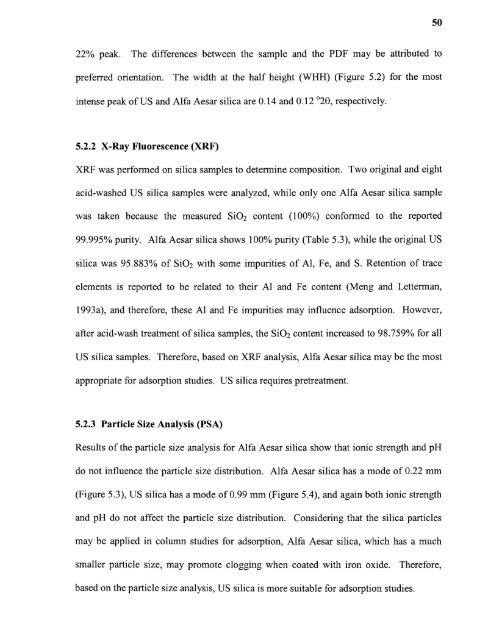Heavy metal adsorption on iron oxide and iron oxide-coated silica ...
Heavy metal adsorption on iron oxide and iron oxide-coated silica ...
Heavy metal adsorption on iron oxide and iron oxide-coated silica ...
You also want an ePaper? Increase the reach of your titles
YUMPU automatically turns print PDFs into web optimized ePapers that Google loves.
5022% peak. The differences between the sample <strong>and</strong> the PDF may be attributed topreferred orientati<strong>on</strong>. The width at the half height (WHH) (Figure 5.2) for the mostintense peak of US <strong>and</strong> Alfa Aesar <strong>silica</strong> are 0.14 <strong>and</strong> 0.12 '20, respectively.5.2.2 X-Ray Fluorescence (XRF)XRF was performed <strong>on</strong> <strong>silica</strong> samples to determine compositi<strong>on</strong>. Two original <strong>and</strong> eightacid-washed US <strong>silica</strong> samples were analyzed, while <strong>on</strong>ly <strong>on</strong>e Alfa Aesar <strong>silica</strong> samplewas taken because the measured SiO2 c<strong>on</strong>tent (100%) c<strong>on</strong>formed to the reported99.995% purity. Alfa Aesar <strong>silica</strong> shows 100% purity (Table 5.3), while the original US<strong>silica</strong> was 95.883% of SiO2 with some impurities of Al, Fe, <strong>and</strong> S. Retenti<strong>on</strong> of traceelements is reported to be related to their Al <strong>and</strong> Fe c<strong>on</strong>tent (Meng <strong>and</strong> Letterman,1993a), <strong>and</strong> therefore, these Al <strong>and</strong> Fe impurities may influence <str<strong>on</strong>g>adsorpti<strong>on</strong></str<strong>on</strong>g>. However,after acid-wash treatment of <strong>silica</strong> samples, the SiO2 c<strong>on</strong>tent increased to 98.759% for allUS <strong>silica</strong> samples. Therefore, based <strong>on</strong> XRF analysis, Alfa Aesar <strong>silica</strong> may be the mostappropriate for <str<strong>on</strong>g>adsorpti<strong>on</strong></str<strong>on</strong>g> studies. US <strong>silica</strong> requires pretreatment.5.2.3 Particle Size Analysis (PSA)Results of the particle size analysis for Alfa Aesar <strong>silica</strong> show that i<strong>on</strong>ic strength <strong>and</strong> pHdo not influence the particle size distributi<strong>on</strong>. Alfa Aesar <strong>silica</strong> has a mode of 0.22 mm(Figure 5.3), US <strong>silica</strong> has a mode of 0.99 mm (Figure 5.4), <strong>and</strong> again both i<strong>on</strong>ic strength<strong>and</strong> pH do not affect the particle size distributi<strong>on</strong>. C<strong>on</strong>sidering that the <strong>silica</strong> particlesmay be applied in column studies for <str<strong>on</strong>g>adsorpti<strong>on</strong></str<strong>on</strong>g>, Alfa Aesar <strong>silica</strong>, which has a muchsmaller particle size, may promote clogging when <strong>coated</strong> with ir<strong>on</strong> <strong>oxide</strong>. Therefore,based <strong>on</strong> the particle size analysis, US <strong>silica</strong> is more suitable for <str<strong>on</strong>g>adsorpti<strong>on</strong></str<strong>on</strong>g> studies.
















